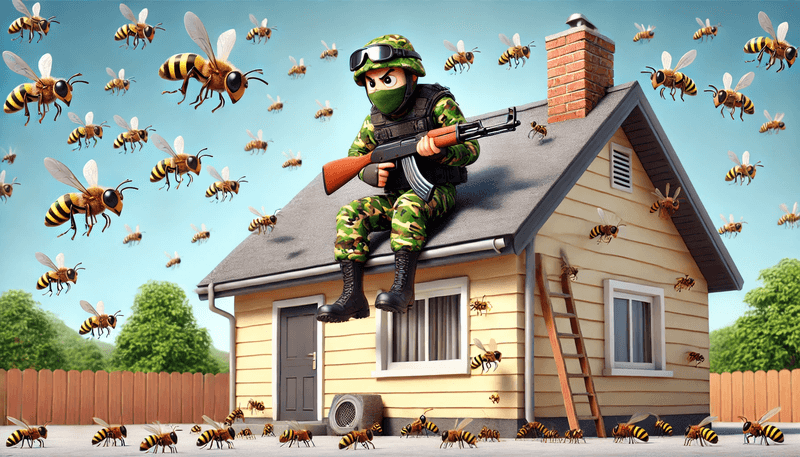
Can You Really Stop Wasps Nesting in Your Loft?
Wasps nesting in your loft can be a real headache. While there's no guaranteed way to completely prevent wasps from entering your loft, the good news is that you can make it much more difficult for them to do so. By sealing potential entry points and maintaining your property, you can reduce the chances of wasps choosing your loft as their new home.
Why Do Wasps Choose Lofts?
Before diving into prevention methods, it's helpful to understand why wasps are attracted to lofts in the first place. Wasps prefer quiet, sheltered areas where they won't be disturbed, making lofts an ideal location. The dark, insulated environment gives them plenty of protection from the elements and predators.
But while you can't eliminate every potential spot for them to nest, you can certainly make your loft less appealing to wasps.
How to Make Your Loft Less Attractive to Wasps
Even though there's no surefire way to completely stop wasps from entering your loft, these steps can significantly reduce the risk of an infestation:
1. Seal Obvious Entry Points
The first and most important step in keeping wasps out of your loft is to block or seal any obvious holes or gaps they could use to get in. Wasps are adept at finding small openings, so thorough inspection and sealing are essential. Here are some key areas to check:
- Gaps around windows: Check any window frames or ventilation areas in the loft for gaps. Seal them up with silicone or weatherproofing material.
- Cracks in walls: Inspect the walls of your loft for cracks or crevices. Even the smallest cracks can become an entry point for wasps.
2. Inspect and Secure Your Chimney
If your home has a chimney. Wasps can enter through gaps around the chimney's lead flashing, especially if it has become loose or worn over time. Ensure the flashing is tight and secure against the chimney's brickwork and the tiles or slates on the roof.
3. Maintain Fascia Boards and Soffits
Your home's fascia boards and soffits are another key area where wasps may gain entry. Over time, these elements can deteriorate, creating gaps or cracks. Ensure your fascia boards and soffits are in good condition and free from holes or damage. Additionally, check for any old or disused overflow pipes that might have left holes.
4. Watch for Soffits Vent Strips
Another common entry point for wasps is through soffit vents. Wasps can easily enter through these gaps. Wasps can fit through surprisingly small spaces, so minor gaps in soffit vents can become problematic. Ensure that the soffits are properly aligned and that there are no gaps around venting areas. If you have soffit vent strips, it's likely, at some point, you will get wasps entering through the vents.
5. Check the Bottom Row of Tiles (Undereave Tiles)
The area where the bottom row of roof tiles touches the fascia board is another place that should be inspected. Wasps may find small gaps under these tiles and use them as an entry point into your loft. Be sure to check this area for any gaps or holes and seal them appropriately to prevent wasps from making their way inside.
6. Secure the Edges of Velux Windows
If your loft has Velux windows, it's important to pay special attention to the edges of the tiles that sit alongside the windows. These edges are a favourite for wasps looking for a place to nest. Ideally, these tiles should be sealed to prevent wasps from entering under these tiles. Wasps can make their nest any shape they like, so they can nest between the tiles and roof membrane
7. Cover Air Bricks and Vents
Any air bricks or vents in your loft, especially on the gable wall, can be an entryway for wasps. While these vents are important for airflow, you can cover them with fine mesh or gauze to prevent wasps from using them as a gateway to your loft. Ensure the mesh is fine enough to block wasps while allowing proper ventilation.
Keep in Mind: Wasps Will Find Another Place to Nest
Even if you take every precaution to prevent wasps from nesting in your loft, they may still find other spots on your property to build their nest. Sheds, garages, and small spaces like birdhouses or under eaves can become alternative nesting areas. Regularly inspecting your property and addressing potential entry points in all structures can minimize the chances of a wasp infestation.
Extractor vents
Another favourite place for wasps to gain access is through extractor vents. They usually build a nest within the tube, which links the bathroom extractor to the vent on the outside. Again, it is possible to cover the plastic vent with a fine mesh or gauze to prevent access while still allowing it to work correctly.
Final Thoughts
While there's no foolproof way to stop wasps from nesting in your loft, you can make it significantly harder for them to gain access. By inspecting your loft for potential entry points and taking the time to seal cracks, gaps, and vents, you'll make your home less inviting for these pests. Remember, it's all about reducing their access and giving them fewer places to call home.
We suggest regular visual checks from mid-June onwards of your property from outside. If you see activity, don't leave it; nip it in the bud before problems occur.
